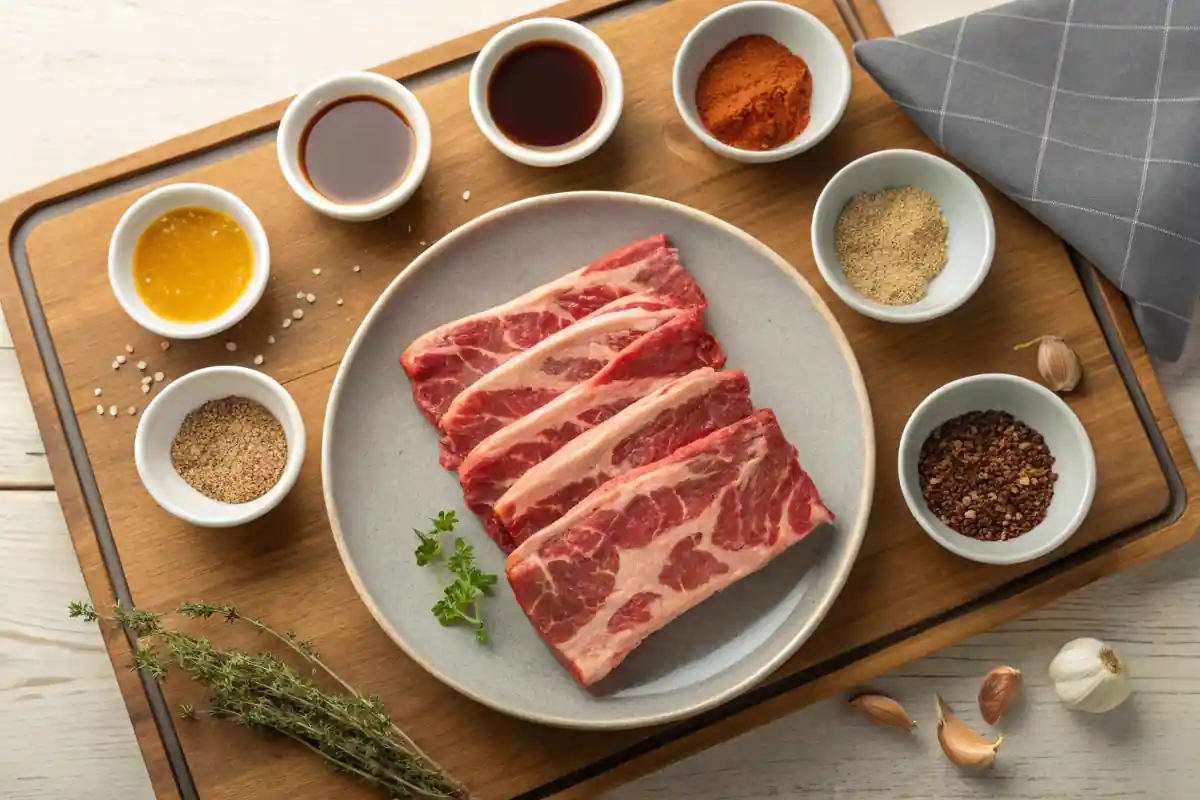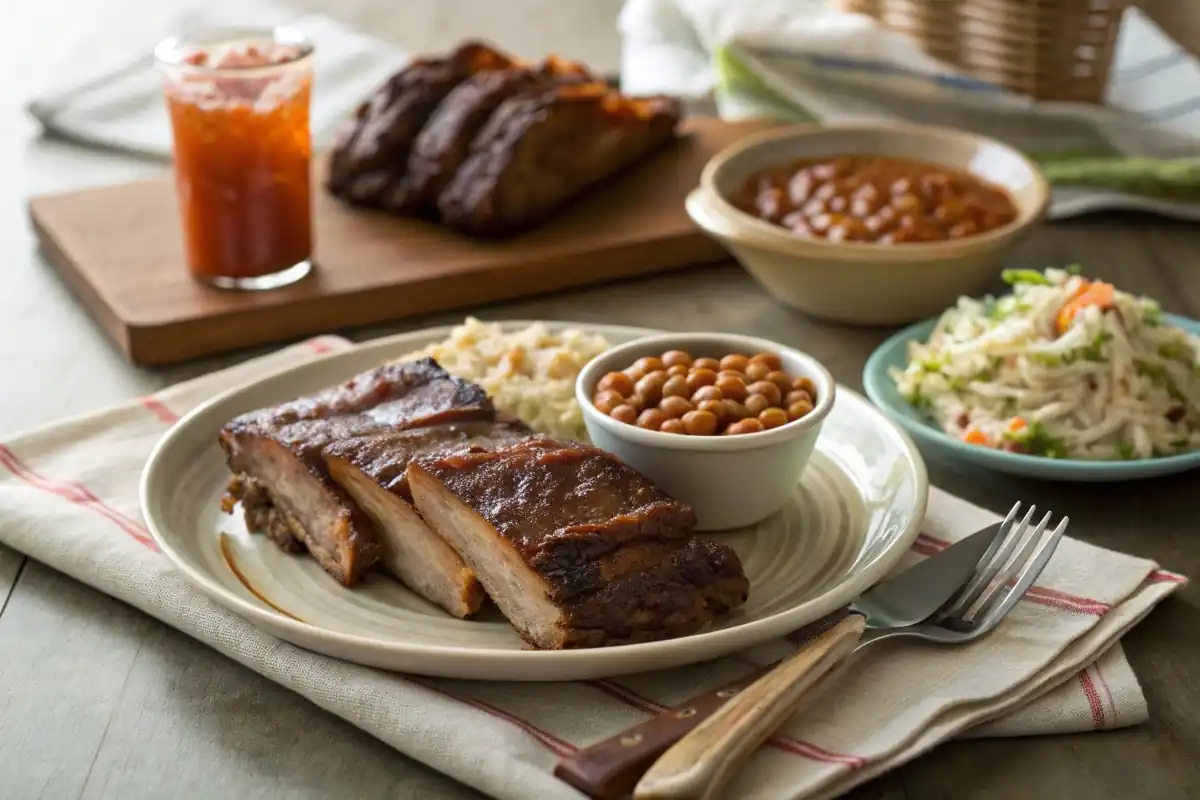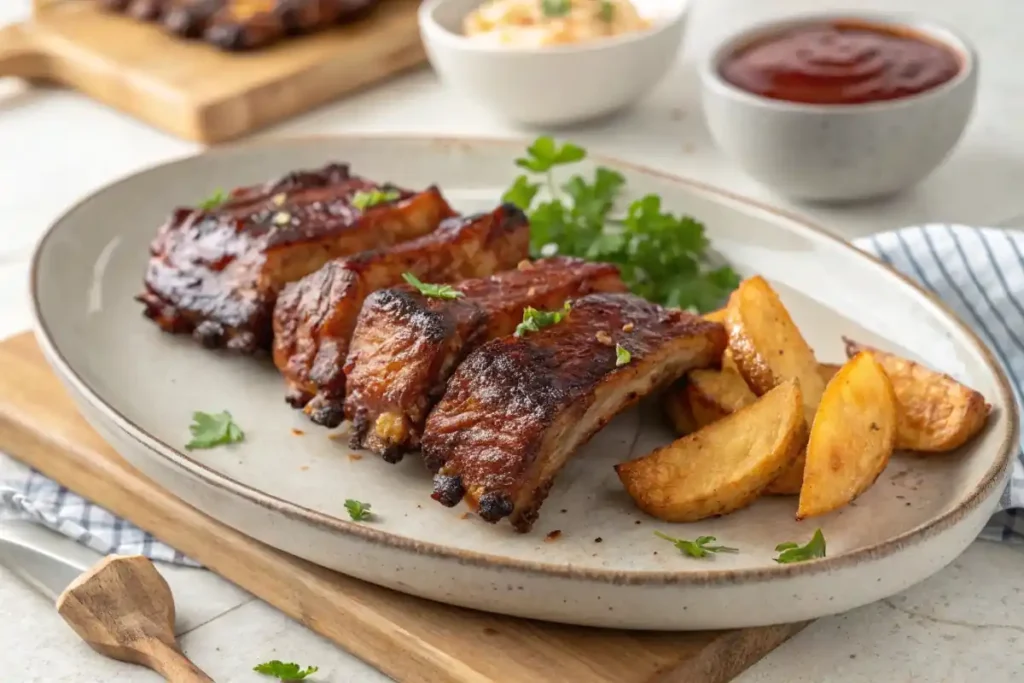When it comes to hearty, mouthwatering meals that satisfy every craving for smoky, savory goodness, beef back ribs reign supreme. These meaty delights, carved from the upper part of the cow’s rib section, are celebrated for their rich flavor and tender texture. Whether you’re a backyard grill master or just beginning your BBQ journey, understanding how to prepare, cook, and enjoy beef back ribs can elevate your culinary skills to gourmet levels.
What Are Beef Back Ribs?
Beef back ribs are a true gem from the cow’s rib primal section, offering flavorful meat nestled between bones left behind after the ribeye roast has been cut away. Unlike short ribs, which are meatier and located lower on the rib cage, beef back ribs are leaner with meat primarily between the bones. But don’t let that fool you—these ribs pack a punch of bold, beefy flavor that makes them perfect for slow-cooking methods like smoking or braising.
One of the best features of beef back ribs is their versatility. They can be prepared in various ways—grilled, oven-baked, or smoked—each method enhancing the natural marbling and tenderness of the meat. Plus, they’re often more affordable than other cuts, making them a fantastic option for family gatherings, game days, or weekend BBQs.
Whether you’re serving them with a smoky BBQ glaze or experimenting with international flavors, these ribs deliver an unforgettable taste experience that keeps diners coming back for more.
Nutritional Profile of Beef Back Ribs
Besides being deliciously indulgent, beef back ribs come packed with a powerhouse of essential nutrients. They’re a solid source of protein, vital for muscle growth and repair, and rich in iron, which supports healthy blood circulation. Additionally, they offer significant amounts of zinc and vitamin B12—key players in maintaining a strong immune system and promoting energy metabolism.
Here’s a breakdown of the nutritional profile for a 3-ounce (85-gram) serving of cooked beef back ribs:
| Nutrient | Amount | % Daily Value |
|---|---|---|
| Calories | 250 | – |
| Protein | 20g | 40% |
| Total Fat | 18g | 28% |
| Saturated Fat | 7g | 35% |
| Iron | 2.5mg | 14% |
| Zinc | 5mg | 45% |
| Vitamin B12 | 2.4mcg | 100% |
Note: Percent Daily Values are based on a 2,000-calorie diet.
That said, while beef back ribs are undeniably rich in nutrients, they are also high in saturated fats. Moderation is key—enjoying these ribs as part of a balanced diet can help you reap the benefits without overindulging in excess fats.
Additionally, choosing leaner cuts or trimming visible fat before cooking can help make this indulgent treat a bit healthier. Pairing beef ribs with fiber-rich vegetables and whole grains can also balance the meal, creating a wholesome dining experience.

Ingredients
For the Beef Back Ribs:
- 2 racks of beef back ribs (about 4-5 pounds total)
- 2 tablespoons olive oil (for coating)
- 2 tablespoons yellow mustard (optional, helps seasoning adhere better)
For the Dry Rub:
- 3 tablespoons brown sugar (for sweetness and caramelization)
- 2 tablespoons smoked paprika (for a deep smoky flavor)
- 1 tablespoon garlic powder
- 1 tablespoon onion powder
- 1 tablespoon ground black pepper
- 1 tablespoon kosher salt
- 1 teaspoon cayenne pepper (for heat, optional)
- 1 teaspoon ground cumin
- 1 teaspoon chili powder
For Spritzing (Moisture & Flavor):
- 1/2 cup apple cider vinegar
- 1/2 cup water
- 1 tablespoon honey (optional, for added sweetness)
For the BBQ Sauce (Optional but Recommended):
- 1 cup tomato ketchup
- 1/4 cup apple cider vinegar
- 1/4 cup brown sugar
- 2 tablespoons honey
- 1 tablespoon Worcestershire sauce
- 1 teaspoon smoked paprika
- 1 teaspoon garlic powder
- 1/2 teaspoon black pepper
- 1/2 teaspoon salt

Step-by-Step Cooking Instructions
Step 1: Preparing the Beef Back Ribs
- Remove the Membrane:
- Place the ribs bone-side up on a cutting board.
- Using a sharp knife, slide the blade under the thin membrane (silverskin) on the back of the ribs.
- Once loosened, grab the membrane with a paper towel (for better grip) and pull it off. Removing the membrane ensures tender ribs and allows flavors to penetrate deeply.
- Trim Excess Fat:
- Using a sharp knife, trim any thick, visible fat from the ribs. Leaving a small amount of fat is okay—it helps keep the meat moist during cooking.
- Apply Mustard and Oil (Optional):
- Rub a thin layer of olive oil and mustard over the entire surface of the ribs. This helps the seasoning stick better and creates a flavorful crust during smoking.
- Season with Dry Rub:
- Mix all dry rub ingredients in a bowl.
- Generously coat both sides of the ribs with the spice rub, ensuring every inch is covered.
- Let the ribs rest for at least 30 minutes at room temperature or refrigerate overnight for maximum flavor infusion.
Step 2: Prepping the Smoker
- Choose Your Wood Chips:
- For classic barbecue flavor, use hickory or oak wood chips. For a touch of sweetness, blend in applewood or cherrywood.
- Preheat the Smoker:
- Set the smoker to 225°F (107°C) for low and slow cooking. This temperature ensures the ribs become tender without drying out.
- Prepare a Water Pan:
- Place a water pan inside the smoker. This helps maintain moisture and creates a humid environment for tender ribs.
Step 3: Smoking the Beef Back Ribs
- Place Ribs on the Smoker:
- Position the ribs bone-side down on the grill grates.
- Close the lid and let the ribs smoke undisturbed for 3 hours.
- Spritz for Moisture:
- Every hour, spray the ribs with a mixture of apple cider vinegar, water, and honey. This keeps the meat moist and enhances the smoky flavor.
- The Texas Crutch Method (Optional for Extra Tenderness):
- After 3 hours of smoking, remove the ribs and wrap them tightly in aluminum foil.
- Add a splash of apple cider vinegar or beef broth inside the foil before sealing.
- Return the wrapped ribs to the smoker for another 2 hours. This helps break down the connective tissue for fall-off-the-bone tenderness.
Step 4: Finishing and Caramelizing the Ribs
- Unwrap and Add Sauce:
- After 5 hours of cooking, remove the foil and place the ribs back on the smoker.
- Brush the ribs generously with homemade BBQ sauce.
- Caramelize the Glaze:
- Smoke the ribs uncovered for an additional 30-60 minutes, allowing the sauce to caramelize and form a sticky, flavorful crust.
- Check Internal Temperature:
- Use a meat thermometer to ensure the internal temperature reaches 203°F (95°C)—the sweet spot for tender ribs.
Step 5: Resting and Serving
- Let the Ribs Rest:
- Remove the ribs from the smoker and let them rest for at least 15 minutes. This allows the juices to redistribute throughout the meat.
- Slice and Serve:
- Cut between the bones into individual ribs.
- Serve with additional BBQ sauce on the side and your favorite sides like creamy coleslaw, baked beans, or grilled vegetables.
Quick Tips for Perfect Ribs
- Always cook low and slow for the best tenderness.
- Use a meat thermometer for accuracy—beef back ribs are best when cooked to an internal temperature of 203°F (95°C).
- Resting the meat after cooking helps keep it juicy and flavorful.
Serving Suggestions
Pair these ribs with:
- Cornbread: Sweet and buttery, perfect for soaking up extra sauce.
- Creamy Garlic Mashed Potatoes: A rich, comforting side.
- Grilled Corn on the Cob: Charred and smoky with melted butter.
How to Choose Quality Beef Back Ribs
Picking the right rack of beef back ribs is the first—and arguably most critical—step in ensuring a tender, mouthwatering result. While all ribs might look similar at a glance, not all cuts are created equal. Here’s what to focus on to get the best possible quality:
1. Look for Marbling:
The secret to flavorful, juicy ribs lies in the fat marbling. Marbling refers to the small streaks of intramuscular fat running through the meat. During cooking, this fat melts into the meat, infusing it with rich flavor and helping to keep the ribs moist. When selecting ribs, look for a good balance—plenty of marbling without large fat deposits that could lead to excessive greasiness.
2. Check the Meat Coverage:
A common issue with beef back ribs is that much of the meat is often trimmed off when the ribeye roast is separated. However, the best racks will still have a decent amount of meat clinging between and over the bones. Look for ribs with a uniform layer of meat and avoid cuts where the bones look too “bare” or stripped down—this typically means you’re getting less meat for your money.
3. Color Is Key:
Fresh beef back ribs should have a rich, cherry-red hue, signaling freshness and proper storage. Avoid ribs with a grayish or brown tint, as this can indicate aging or poor preservation. Also, the fat should be creamy white rather than yellowish—discoloration in fat can signal old meat.
4. Avoid Ribs With Excessive Bone Splintering:
Inspect the rack for any signs of bone damage. Broken or splintered bones can make eating unpleasant and are usually a sign of rough butchering. Choose racks with intact, evenly spaced bones for a better presentation and cooking experience.
5. Talk to Your Butcher:
If possible, buy your beef back ribs from a trusted butcher rather than a supermarket. Butchers often offer better-quality cuts and can give expert advice on the freshest racks available. Don’t hesitate to ask for a custom cut if you’re looking for meatier ribs or a specific size for your grill.
6. Opt for Grass-Fed or Organic Beef:
If you’re after the highest quality, consider sourcing grass-fed, organic, or locally raised beef. Grass-fed meat tends to be leaner but offers a more robust, natural flavor profile. It’s also free from added hormones or antibiotics, making it a healthier choice overall.

Health Considerations
Are Beef Back Ribs Healthy?
Beef back ribs are undeniably delicious, but are they a healthy choice? The answer largely depends on how they’re prepared, portion sizes, and how often they’re consumed. Like most red meat cuts, beef back ribs can be part of a balanced diet when enjoyed in moderation and cooked with health-conscious methods.
Nutritional Benefits:
Beef back ribs are rich in high-quality protein, which is essential for muscle repair, immune function, and overall body maintenance. They’re also packed with vital nutrients, including:
- Iron: Supports healthy red blood cell production and oxygen transport.
- Zinc: Strengthens the immune system and aids in wound healing.
- Vitamin B12: Supports nerve function and energy metabolism.
Health Considerations:
The main health concern with beef back ribs is their fat content—particularly saturated fat. A typical serving can be high in calories and cholesterol, which could increase the risk of heart disease if consumed excessively.
To make your ribs healthier:
- Trim visible fat before cooking.
- Opt for grilling, baking, or smoking instead of frying.
- Pair with nutrient-dense sides like grilled vegetables or salads.
Portion Control Is Key:
Enjoying beef back ribs occasionally and in reasonable portions (around 3-4 ounces of meat) allows you to savor their bold flavors while maintaining a balanced diet. Pairing them with fiber-rich vegetables and whole grains can help balance out the meal.
Cultural Significance of Beef Back Ribs
Beef Back Ribs in Various Cuisines
Across the globe, beef back ribs hold a special place in many culinary traditions, with each culture bringing its unique flavors, techniques, and rituals to this beloved cut of meat. From slow-smoked American barbecues to savory Asian marinades, beef ribs are a versatile dish that transcends borders.
1. American Barbecue Tradition:
In the United States, particularly in the South, beef back ribs are a staple of classic BBQ culture. Smoked low and slow over woods like hickory or oak, they’re typically seasoned with a bold dry rub and finished with a tangy barbecue sauce. Texas-style barbecue stands out for its simple seasoning—often just salt and pepper—allowing the natural beef flavors to shine.
2. Korean Cuisine – Galbi (갈비):
In Korea, beef back ribs are the star of galbi, a marinated grilled dish. The ribs are soaked in a sweet and savory marinade made from soy sauce, garlic, sesame oil, and pear puree. Grilled over open flames, the result is a tender, caramelized, and flavorful delicacy often served with rice and pickled vegetables.
3. Argentine Asado:
In Argentina, asado is more than a meal—it’s a social event. Beef back ribs are seasoned with coarse salt and slowly grilled over wood-fired embers. This method emphasizes simplicity, allowing the rich, natural flavors of the meat to develop, accompanied by chimichurri sauce for an herby kick.
4. Brazilian Churrasco:
Brazilian churrasco features skewered beef ribs cooked over open flames. The meat is often seasoned with just rock salt before being grilled, resulting in tender, juicy ribs with a smoky, charred crust—a highlight at any traditional Brazilian barbecue.
These cultural variations highlight the universal love for beef back ribs and showcase the incredible diversity of flavors, techniques, and traditions that make this cut so globally cherished.
Frequently Asked Questions (FAQs)
What are beef back ribs?
Beef back ribs are the flavorful bones that remain after the ribeye roast is removed from the cow. Cut from the upper section of the rib cage, these ribs typically have meat nestled between the bones rather than on top. While they contain less meat than other cuts, their rich, beefy flavor makes them a popular choice for barbecuing and smoking. When cooked low and slow, the meat becomes tender, juicy, and packed with smoky goodness.
Which is better: beef back ribs or short ribs?
Choosing between beef back ribs and short ribs depends on personal preference and the type of dish you’re aiming to create. Beef back ribs are leaner, with meat mainly between the bones, making them ideal for grilling or smoking to achieve that classic BBQ flavor. On the other hand, short ribs are meatier, richer, and best suited for slow-cooked dishes like braises and stews, where their marbling melts into tender perfection.
Are beef back ribs healthy?
Yes, beef back ribs can be part of a balanced diet when consumed in moderation. They’re packed with high-quality protein, iron, zinc, and vitamin B12, which support muscle growth, energy production, and immune function. However, they are also high in saturated fat and calories. To make them healthier, trim excess fat, use lean cuts, and pair them with vegetables or whole grains for a more balanced meal.
What’s the difference between beef and pork baby back ribs?
The key difference lies in the source and flavor profile. Beef back ribs come from cattle and have a bold, robust flavor that pairs well with smoky seasonings and hearty sauces. In contrast, pork baby back ribs are cut from pigs and offer a milder, slightly sweet flavor with a more tender texture. Pork ribs also cook faster, making them ideal for quicker meals, while beef ribs excel in slow-cooking methods that allow their rich flavors to develop.
Conclusion
Embracing the Flavor of Beef Back Ribs
Beef back ribs offer a culinary adventure that combines bold flavors, tender textures, and rich cultural history. From selecting the perfect rack at the butcher shop to slow-smoking them to perfection, this cut of meat is a versatile canvas for both classic and creative recipes. Whether you’re diving into a smoky Texas-style BBQ, indulging in the sweet and savory notes of Korean galbi, or experimenting with spicy chipotle marinades, beef back ribs never fail to deliver a satisfying experience.

